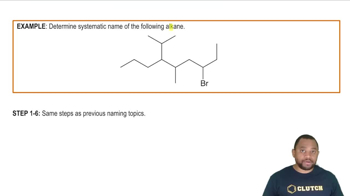Here are the essential concepts you must grasp in order to answer the question correctly.
Aromatic Compounds
Aromatic compounds are a class of cyclic compounds that follow Huckel's rule, which states that they must have a planar structure with a specific number of pi electrons (4n + 2, where n is a non-negative integer). These compounds exhibit unique stability due to resonance, which allows for delocalization of electrons across the ring structure. Understanding the properties of aromaticity is essential for drawing and predicting the behavior of compounds like isopropylbenzene and 1-chloro-4-methylbenzene.
Recommended video:
Substituent Effects
Substituent effects refer to how different groups attached to a benzene ring influence its reactivity and the positions where new substituents can be added. For example, alkyl groups like isopropyl are generally electron-donating and direct incoming substituents to the ortho and para positions, while halogens like chlorine are electron-withdrawing and direct substituents to the meta position. Recognizing these effects is crucial for accurately drawing the structures of substituted benzene derivatives.
Recommended video:
Naming Other Substituents Example
Structural Representation
Structural representation in organic chemistry involves depicting the arrangement of atoms within a molecule, including bonds and functional groups. Common methods include Lewis structures, condensed formulas, and skeletal structures. For the compounds in question, accurately representing the isopropyl and chloro substituents on the benzene ring is vital for understanding their chemical properties and reactivity.
Recommended video:
 Verified step by step guidance
Verified step by step guidance


